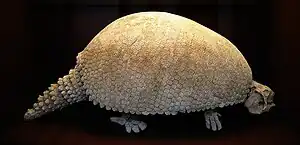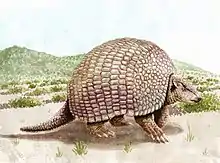| Glyptodonts | |
|---|---|
 | |
| Glyptodon fossil, Natural History Museum, Vienna | |
| Scientific classification | |
| Domain: | Eukaryota |
| Kingdom: | Animalia |
| Phylum: | Chordata |
| Class: | Mammalia |
| Order: | Cingulata |
| Family: | Chlamyphoridae |
| Subfamily: | †Glyptodontinae Burmeister 1879 |
| Genera | |
| |
Glyptodonts are an extinct clade of large, heavily armoured armadillos, reaching up to 1.5 metres (4.9 ft) in height, and maximum body masses of around 2 tonnes. They had short, deep skulls, a fused vertebral column, and a large bony carapace made up of hundreds of individual scutes. Some glyptodonts had clubbed tails, similar to ankylosaurid dinosaurs.[1]
The earliest widely recognised fossils of glyptodonts in South America are known from the late Eocene, around 38 million years ago, and they spread to southern North America after the continents became connected around 2.7 million years ago.[2] The best-known genus within the group is Glyptodon.
Glyptodonts were historically considered to constitute the distinct family Glyptodontidae, with their relationships to modern armadillos being contested. In 2016, an analysis of the mitochondrial genome of Doedicurus found that it was, in fact, nested within the modern armadillos as the sister group of a clade consisting of Chlamyphorinae (fairy armadillos) and Tolypeutinae (giant, three-banded and naked-tailed armadillos). For this reason, glyptodonts and all armadillos but Dasypus (long-nosed or naked-tailed armadillos) were relocated to a new family, Chlamyphoridae, and glyptodonts were demoted to the subfamily Glyptodontinae.[2][1] Other authors have continued to use Glyptodontidae.[3] Based on the morphology of the inner ear, a close relationship with pampatheres has also been proposed.[4]
Glyptodonts abruptly became extinct approximately 12,000 years ago at the end of the Late Pleistocene, as part of the Quaternary extinction event, along with most other large animals in the Americas. Evidence has been found suggesting that they were hunted by recently arrived Paleoindians, which may have played a role in their extinction.[3]
Evolution
Glyptodonts first evolved during the Eocene in South America, which remained their center of species diversity. For example, an Early Miocene glyptodont with many primitive features (comparatively to other species), Parapropalaehoplophorus septentrionalis, was discovered at a now-elevated site in Chile and described in 2007.[5] After the Isthmus of Panama formed about three million years ago, the genus Glyptotherium spread north as part of the Great American Interchange, as did pampatheres, armadillos and a number of other types of xenarthrans (e.g., ground sloths).
| Cladogram of Cingulata[2][6][7] | |||||||||||||||||||||||||||||||||||||||||||||||||||||||||||||||||||||
|
Description

Glyptodonts possessed a tortoise-like body armour, made of bony deposits in their skin called osteoderms or scutes. Each species of glyptodont had a unique osteoderm pattern and shell type. With this protection, they were armored like turtles; glyptodonts could not withdraw their heads, but their armoured skin formed a bony cap on the top of their skull. Glyptodont tails had a ring of bones for protection. Doedicurus possessed a large mace-like spiked tail that it would have used to defend itself against predators and, possibly, other Doedicurus. Glyptodonts had the advantage of large size. Many, such as the type genus, Glyptodon, were the size of modern automobiles. The presence of such heavy defenses suggests they were prey of a large, effective predator. At the time that glyptodonts evolved, the apex predators in the island continent of South America were phorusrhacids, a family of giant flightless carnivorous birds.
In physical appearance, glyptodonts superficially resembled the much earlier dinosaurian ankylosaurs and, to a lesser degree, the recently extinct giant meiolaniid turtles of Australia. These are examples of the convergent evolution of unrelated lineages into similar forms. The largest glyptodonts could weigh up to 2,000 kilograms. Like most of the megafauna in the Americas, they all became extinct at the end of the last ice age 10,000 years ago.[8]
Behaviour

Glyptodonts were grazing herbivores. Like many other xenarthrans, they had no incisor or canine teeth, but had a number of cheek teeth that would have been able to grind up tough vegetation, such as grasses. They also had distinctively deep jaws, with large downward bony projections that would have anchored their powerful chewing muscles.[9]
Extinction
Glyptodonts became extinct at the end of the last ice age along with a large number of other megafaunal species, including pampatheres, the giant ground sloths, and Macrauchenia. Their much smaller, more lightly armored and flexible armadillo relatives survived. The extinction of the glyptodonts coincided with the arrival of early humans in the Americas. Archeological evidence suggests that these humans made use of the animals' armored shells,[10] however, other causes cannot be ruled out.
References
- 1 2 Mitchell, Kieren J.; Scanferla, Agustin; Soibelzon, Esteban; Bonini, Ricardo; Ochoa, Javier; Cooper, Alan (July 2016). "Ancient DNA from the extinct South American giant glyptodont Doedicurus sp. (Xenarthra: Glyptodontidae) reveals that glyptodonts evolved from Eocene armadillos". Molecular Ecology. 25 (14): 3499–3508. doi:10.1111/mec.13695. ISSN 0962-1083.
- 1 2 3 Delsuc, F.; Gibb, G. C.; Kuch, M.; Billet, G.; Hautier, L.; Southon, J.; Rouillard, J.-M.; Fernicola, J. C.; Vizcaíno, S. F.; MacPhee, R. D.E.; Poinar, H. N. (2016-02-22). "The phylogenetic affinities of the extinct glyptodonts". Current Biology. 26 (4): R155–R156. doi:10.1016/j.cub.2016.01.039. PMID 26906483.
- 1 2 Carlini, Alfredo A.; Carrillo-Briceño, Jorge D.; Jaimes, Arturo; Aguilera, Orangel; Zurita, Alfredo E.; Iriarte, José; Sánchez-Villagra, Marcelo R. (December 2022). "Damaged glyptodontid skulls from Late Pleistocene sites of northwestern Venezuela: evidence of hunting by humans?". Swiss Journal of Palaeontology. 141 (1). doi:10.1186/s13358-022-00253-3. ISSN 1664-2376.
- ↑ Tambusso, P. Sebastián; Varela, Luciano; Góis, Flávio; Moura, Jorge Felipe; Villa, Chiara; Fariña, Richard A. (June 2021). "The inner ear anatomy of glyptodonts and pampatheres (Xenarthra, Cingulata): Functional and phylogenetic implications". Journal of South American Earth Sciences. 108: 103189. doi:10.1016/j.jsames.2021.103189.
- ↑ Case Western Reserve University. "Andean Highlands In Chile Yield Ancient South American Armored Mammal Fossil". Science Daily. Retrieved 2007-12-14.
- ↑ Upham, Nathan S.; Esselstyn, Jacob A.; Jetz, Walter (2019). "Inferring the mammal tree: Species-level sets of phylogenies for questions in ecology, evolution and conservation". PLOS Biol. 17 (12): e3000494. doi:10.1371/journal.pbio.3000494. PMC 6892540. PMID 31800571.
- ↑ Gibb, Gillian C.; Condamine, Fabien L.; Kuch, Melanie; Enk, Jacob; Moraes-Barros, Nadia; Superina, Mariella; Poinar, Hendrik N.; Delsuc, Frédéric (2015). "Shotgun Mitogenomics Provides a Reference PhyloGenetic Framework and Timescale for Living Xenarthrans". Molecular Biology and Evolution. 33 (3): 621–642. doi:10.1093/molbev/msv250. PMC 4760074. PMID 26556496.
- ↑ "Extinct glyptodonts really were gigantic armadillos, ancient DNA shows". Retrieved 2016-09-11.
- ↑ Palmer, D., ed. (1999). The Marshall Illustrated Encyclopedia of Dinosaurs and Prehistoric Animals. London: Marshall Editions. p. 208. ISBN 1-84028-152-9.
- ↑ Smithsonianmag.com, "A History of Life in 10 Fossils", Smithsonian Magazine, 15 October 2014
External links
- Glyptodont article at ScienceBlogs, with photos
- Ernest Ingersoll (1920). . Encyclopedia Americana.


